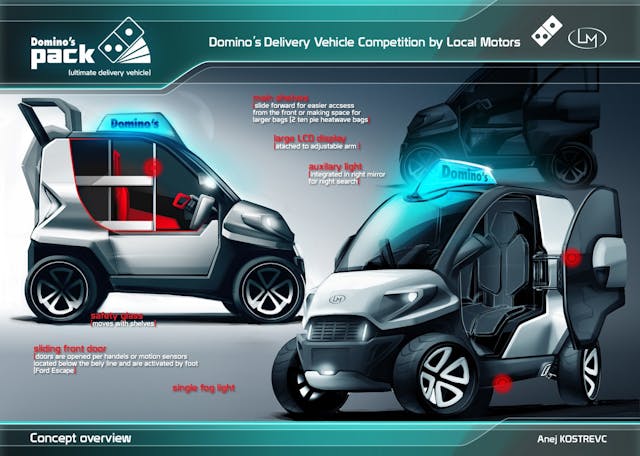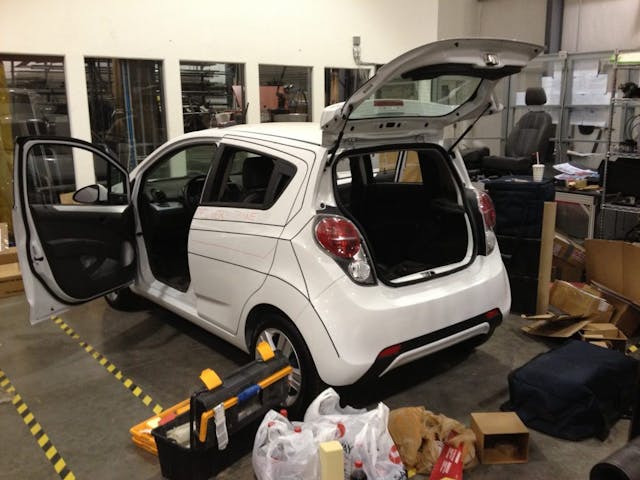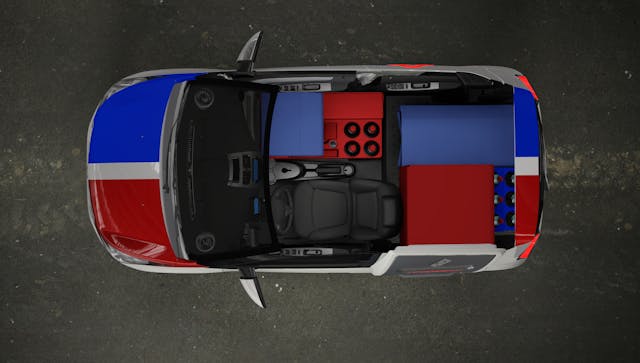Why Domino’s DXP delivery cars were anything but half-baked
Back in 2015, Domino’s unveiled the DXP (Delivery Expert) delivery car, a Chevy Spark-based runabout that, through a collaboration with small-batch vehicle-designer Local Motors (LM), sought to revolutionize the pizza delivery experience. From the outside, the DXPs appeared to be mostly normal Sparks with a pizza oven taking up the space that the rear driver’s side seat normally would.

When a tweet recently surfaced showing a picture of one of the DXP delivery vehicles in a junkyard, one of the designers who worked on the team that designed the little workhorses responded, and we got in touch to learn the full story. Nicolas de Peyer is a Colorado-based designer and in 2013, he was the Local Motors community liaison and design lead on the DXP cars. In a series of tweets responding to the junk-ified DXP, de Peyer spun a yarn not of struggles with marketing gimmicks, but of the incredible collaboration of a global design community, an amazing human-centered study, and what happens when a client’s request takes a sudden right turn. Grab a slice and come along for the ride.
Dominos initially wanted a ground up totally new cool looking car that was both for delivery but more for a marketing tool than anything. It was more about exposure and ‘innovation’ than anything when they came to us. They wanted to reinvent pizza delivery. Oh Yes They Did! 2/x
— Nyko (@idesigncars) July 7, 2020
In 2010, Domino’s launched the “Oh Yes We Did” campaign in an effort to show customers how it was reimagining pizza from the crust up. Keen to continue building the goodwill from that campaign, Domino’s tapped LM to help orchestrate a design competition to envision the world’ perfect pizza delivery vehicle. As de Peyer recalls, the brief was simple: Domino’s invented pizza delivery, so design a vehicle that will reinvent the practice of delivery, similar to how the rest of the company had recently transformed itself. Rather than use an existing vehicle platform, Domino’s wanted to blow the world’s collective mind with a completely new vehicle.
Initial meetings involved everyone from the Domino’s chief marketing officer, to a franchise owner, head chef, and an actual delivery driver. Also present was Kenneth Baker, an outside consultant not affiliated with Local Motors nor Domino’s. A former R&D executive for GM, Baker was responsible for the development of GM’s notorious EV1 electric car. “He was basically there to make sure Domino’s understood what cars were,” explained de Peyer, noting that his experience with small-batch, non-traditional projects like this would help ensure that Domino’s didn’t get hoodwinked by an opportunistic firm.
LM was essentially given carte blanche for the project, but Domino’s made it clear that it was serious about seeing the resulting vehicle pressed into service, eventually. “At one point, they were talking about building 5000 of them,” said de Peyer. Acting as the community manager for LM’s community of designers, he was in charge of synthesizing Domino’s desires into design briefs that were then disseminated within LM’s global community of talented designers. The end result would be a “co-created” set of winning designs for each of the five categories: exterior design, packaging, interior design, surfacing, and rendering.

Out of 300 entrants for the first category, Slovenian designer Anej Kostrevic took the top spot with his idea, dubbed “The Pack,” pictured above. When LM and Domino’s met to discuss the details of going forward with the design, the $30-50M price-tag to execute the program was a bit of a wakeup call. Here’s a tweet from de Peyer summarizing the moment:
In between phase 1 n 2 we cost estimated what it would take to do a full vehicle program to build the Pack. Easily $30-50M. Dominos was like ‘ohhhh, yeah we make Pizza not cars!’. So we had to pivot and look at existing vehicles to base this off of. 6/x
— Nyko (@idesigncars) July 7, 2020
“That [pivot] was probably the most stressful part of the entire project,” noted de Peyer. Local Motors was in a particularly tough spot, because it relies on a community of designers for ideas, with the promise of advocacy to the client that the ideas be executed as close to the original as possible. “All vehicle designers want to see their idea basically go from sketch to perfection exactly how they envision it, and that rarely ever happens.” Predictably, when LM had to return to its online community and announce the pivot, many of the designers lost interest and abandoned the project.
Nervous but resolute, the LM team turned its attention to existing subcompact vehicles. As de Peyer recalls, candidates included the Ford Fiesta, Scion iQ, Fiat 500, Nissan Cube, Honda Fit, Chevy Sonic, and the Chevy Spark. They went deep into research, building a large spreadsheet to account for qualities like fuel economy, warranties, operating costs, even going so far as to evaluate the dealer networks in and around the DXP’s targeted metropolitan areas on availability of maintenance support. For example: this whole project happened between 2012-2013, and because Fiat was relatively new to the U.S. market, the dealership network was extremely weak and therefore caused it to fall down the list.

It didn’t stop there: “For two days, the [delivery]driver and I went to car dealerships and sat in each car, we took Heatwave bags and sat in each car,” recalls de Peyer. The pair would film ingress and egress for both the driver and the heatwave bag (the pizza bags that Domino’s drivers pizzas in when out for delivery; these highly insulated bags lose just 1 degree of heat every hour) and use the film to evaluate the virtues of each model. Needless to say, dealership staff were less than thrilled that they weren’t actually getting free pizza.
Eventually, the Chevy Spark won out, thanks to superior fuel economy (the 2013 spark was rated for 36 mpg highway), ease-of-use in tight areas, and a huge dealer network that made for easy serviceability. While these aspects are true of most of the candidates, de Peyer also suspects that the outside consultant hired by Domino’s had some sway in the matter—as a former GM exec, he had experience with how low-volume specialty vehicles like the DXP worked within the larger GM organization. Nevertheless, they had their platform, and it was time to get going.
“When we went back to the community and [told them] the Spark is it, oh man, that was a tough moment,” recalls de Peyer. Thankfully, a faithful cadre of designers stuck around to soldier on with the existing parameters, plunging headlong into the interior design phase.

While discussing earlier interior components with the delivery driver, the team realized that cars are fundamentally designed for humans, not to carry pizzas. “Car seats are designed for butts, not pizzas,” explained de Peyer. This seems obvious, but consider the implications—that means the seats are angled front to back. Throw a hot pizza down on there, and you risk the toppings sliding to one side prior to the destination. “Delivery drivers slam on their brakes, think about two-liter bottles of soda, why are those round? There’s no good way to stow a two-liter bottle of soda in an existing car. You can put it in the footwell, but it’s gonna roll around, and then when you get to the destination, you have a soda bomb,” he continued.

The typical delivery order is two pizzas and a soda—there’s a lot of potential for disappointed customers when a delivery driver has to work within the shortcomings of an existing car. These are the problems that de Peyer and his team realized needed tackling. A disappointed customer means a weak tip, and as the LM team learned, the tips were the key metric by which to measure the success of the project. Aside from just making the inside better for the transport of pizza, the team focused on optimizing the vehicle for every part of the pie-toting experience, including load-in and load-out. De Peyer summarizes the breakthrough nicely:
“The light went off in my head and I was like wait a second here, the magic in this whole project is the time it takes to get a pizza in the car and out of the car. If you can reduce that, and if you design the interior to be able to accommodate pizzas [and other things like dipping sauce] easily, you reduce the amount of time it takes the driver to get in and out of the car, and you can increase the number of deliveries they can make in a shift.”
If we could help a driver shave at least 30 seconds off each delivery, that would equate to an extra $3-5k a year. IN TIPS!!!. See, if you shave that time off, it could help a driver get an extra 1-4deliveries in/shift. Do that over 52 weeks at $5-8/ tip and voila. 15/x
— Nyko (@idesigncars) July 7, 2020
With guiding starts like pizza security, soda bomb prevention, and reductions in delivery time, the LM team started to gain momentum. Chevy Sparks arrived and were immediately stripped of most of their interiors—out went the angled passenger seats, in went cardboard mock-ups for interior storage consoles. The remainder of the time on the project was spent optimizing the trunk space, the passenger seat, and yes, even that pizza oven loaded from the outside.

The eventual build contract for the final design was awarded to Roush Industries—the same folks who build tactical F-150 pickups and fire-breathing Mustangs. The team at Roush discovered that if it ordered the Sparks with the optional Winter Package, it could simply re-wire the passenger seat heater to power the oven behind the driver. As de Peyer pointed out, the heatwave bags that Domino’s pizzas come is normally plenty effective in regards to heat retention, but a car with a built-in pizza oven is a lot better for grabbing headlines than a portable pizza bag with some logos on it.
I asked de Peyer to summarize the driving force behind the project’s success. “In human-centered design, you start with empathy toward the end-user. The shift here went from designing a delivery vehicle for Domino’s to designing a delivery vehicle for the delivery driver,” explained. He’s humble when it comes to his role in the car. “Even though I essentially became the project manager on the Domino’s car, the community is who created it and designed it, and in the world of car design, it’s rare to have a car that is truly co-created like this one. I was just a small part of the process.”
154 examples of the DXP cars were built. Along with the delivery driver, each DXP car could carry up to 45 pizzas, 12 two-liter sodas, and all the extra dipping sauces one could ever want. Add to that the fact that the car’s still held their five-year 100,000-mile warranty, were cheap on gas, and created a surprising amount of buzz, it is hard not to look at the DXP program as a success, low production aside.
The next time you got to order a pie from Domino’s, maybe you’ll get lucky enough for it to arrive in a DXP. (Who doesn’t love still-lava-hot delivery pizza?) Oh yes, they did, but I’d be willing to bet this isn’t the last purpose-built pizza delivery vehicle the world sees. Whoever takes this concept to the next level will surely be looking to the DXP for inspiration on human-centered, pizza-perfect design and engineering.


